Developer Guide
- 1. Preface
- 2. How to use this Developer Guide
- 3. Design
- 4. Implementation
- 5. Documentation, logging, testing, configuration, dev-ops
-
6. Appendix: Requirements
- 6.1 Product scope
- 6.2 User stories
-
6.3 Use cases
- 6.3.1 Use case: UC1 - Add a client
- 6.3.2 Use case: UC2 - List all clients
- 6.3.3 Use case: UC3 - View a client
- 6.3.4 Use case: UC4 - Delete a client
- 6.3.5 Use case: UC5 - Edit a client
- 6.3.6 Use case: UC6 - Add a meeting
- 6.3.7 Use case: UC7 - List all meetings
- 6.3.8 Use case: UC8 - View a meeting
- 6.3.9 Use case: UC9 - Delete a meeting
- 6.3.10 Use case: UC10 - Edit a meeting
- 6.3.11 Use case: UC11 - Add a product
- 6.3.12 Use case: UC12 - List all products
- 6.3.13 Use case: UC13 - Delete a product
- 6.4 Non-Functional Requirements
- 6.5 Glossary
- 7. Appendix: Instructions for manual testing
- 8. Appendix: Effort
1. Preface
1.1 Introduction
MyInsuRec is a desktop app for financial advisors. It provides financial advisors with clients, meetings and products management abilities to ease their mental load. It also provides some customer relations features such as the ability to look up clients with upcoming birthdays.
This developer guide serves as a documentation to help future developers better understand the system design of MyInsuRec. The guide includes sections on architecture diagrams of MyInsuRec, rationale for feature implementation, product requirements as well as some test cases for manual testing, and more.
Do look through this developer guide if you are interested in developing MyInsuRec further.
1.2 Acknowledgements
- MyInsuRec is a brown-field project based on the AB3 project template by se-education.org.
1.3 Setting up, getting started
Refer to the guide Setting up and getting started.
2. How to use this Developer Guide
Thank you for your interest in MyInsuRec!
This guide smooths the learning curve and helps you understand the internals of MyInsuRec.
If you are seeking to understand the internals of MyInsuRec, check out:
If you are interested in getting to understand the product’s target user and how our product fits their needs, check out:
If you want to test our product’s features, check out:
Lastly, we also share our difficulties and challenges faced under:
We once again thank you for your interest in MyInsuRec. If you have any questions or feedback about MyInsuRec, feel free to reach out to us at myinsurec@gmail.com.
3. Design
This section gives you a high-level overview of the internal design of MyInsuRec, and goes lower-level as you move along the section.
.puml files used to create diagrams in this document can be found in the diagrams folder. Refer to the PlantUML Tutorial at se-edu/guides to learn how to create and edit diagrams.
3.1 Architecture

The Architecture Diagram given above explains the high-level design of the App.
Given below is a quick overview of main components and how they interact with each other.
3.1.1 Main components of the architecture
Main has two classes called Main and MainApp. It is responsible for,
- At app launch: Initializes the components in the correct sequence, and connects them up with each other.
- At shut down: Shuts down the components and invokes cleanup methods where necessary.
Commons represents a collection of classes used by multiple other components.
The rest of the App consists of four components.
-
UI: The UI of the App. -
Logic: The command executor. -
Model: Holds the data of the App in memory. -
Storage: Reads data from, and writes data to, the hard disk.
3.1.2 How the architecture components interact with each other
The Sequence Diagram below shows how the components interact with each other for the scenario where the user issues the command delClient i/1 (deletes the client found at index 1).

Each of the four main components (also shown in the diagram above),
- defines its API in an
interfacewith the same name as the Component. - implements its functionality using a concrete
{Component Name}Managerclass (which follows the corresponding APIinterfacementioned in the previous point.
For example, the Logic component defines its API in the Logic.java interface and implements its functionality using the LogicManager.java class which follows the Logic interface. Other components interact with a given component through its interface rather than the concrete class (reason: to prevent outside component’s being coupled to the implementation of a component), as illustrated in the (partial) class diagram below.

The sections below give more details of each component.
3.2 UI component
The API of this component is specified in Ui.java

The UI consists of a MainWindow that is made up of parts e.g.CommandBox, ResultDisplay, ClientListPanel, StatusBarFooter etc. All these, including the MainWindow, inherit from the abstract UiPart class which captures the commonalities between classes that represent parts of the visible GUI.
The UI component uses the JavaFx UI framework. The layout of these UI parts are defined in matching .fxml files that are in the src/main/resources/view folder. For example, the layout of the MainWindow is specified in MainWindow.fxml
The UI component
- executes user commands using the
Logiccomponent. - listens for changes to
Modeldata so that the UI can be updated with the modified data. - Updates the currently displayed panel to one of the five different types (clients list, meetings list, products list, detailed client view, detailed meeting view) based on the result of the last command executed.
- keeps a reference to the
Logiccomponent, because theUIrelies on theLogicto execute commands. - depends on some classes in the
Modelcomponent, as it displaysClient,Meeting, andProductobjects residing in theModel.
3.3 Logic component
API : Logic.java
Here’s a (partial) class diagram of the Logic component:

How the Logic component works:
- When
Logicis called upon to execute a command, it uses theMyInsuRecParserclass to parse the user command. - This results in a
Commandobject (more precisely, an object of one of its subclasses e.g.,AddClientCommand) which is executed by theLogicManager. - The command can communicate with the
Modelwhen it is executed (e.g. to add a client). - The result of the command execution is encapsulated as a
CommandResultobject which is returned fromLogic.
The Sequence Diagram below illustrates the interactions within the Logic component for the execute("addClient n/John Tan p/12345678") API call.

DeleteClientCommandParser should end at the destroy marker (X) but due to a limitation of PlantUML, the lifeline reaches the end of diagram.
Here are the other classes in Logic (omitted from the class diagram above) that are used for parsing a user command:

How the parsing works:
- When called upon to parse a user command, the
MyInsuRecParserclass creates anXYZCommandParser(XYZis a placeholder for the specific command name e.g.,AddClientCommandParser) which uses the other classes shown above to parse the user command and create aXYZCommandobject (e.g.,AddClientCommand) which theMyInsuRecParserreturns back as aCommandobject. - All
XYZCommandParserclasses (e.g.,AddClientCommandParser,DeleteClientCommandParser, …) inherit from theParserinterface so that they can be treated similarly where possible e.g, during testing.
3.4 Model component
3.4.1 Overall structure
API : Model.java

The Model component,
- stores the MyInsuRec data i.e., all
Clientobjects (which are contained in aUniqueClientListobject). - stores the currently ‘selected’
Clientobjects (e.g., results of a search query) as a separate filtered list which is exposed to outsiders as an unmodifiableObservableList<Client>that can be ‘observed’ e.g. the UI can be bound to this list so that the UI automatically updates when the data in the list change. - stores a
UserPrefobject that represents the user’s preferences. This is exposed to the outside as aReadOnlyUserPrefobjects. - does not depend on any of the other three components (as the
Modelrepresents data entities of the domain, they should make sense on their own without depending on other components) -
Client,MeetingandProducthave attributes here that are abstracted and portrayed in the following subsections. Not all dependencies and composition will be shown.
3.4.2 Client
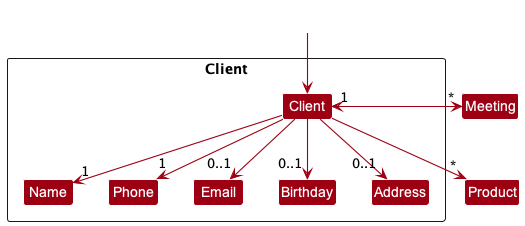
3.4.3 Meeting

3.4.4 Product
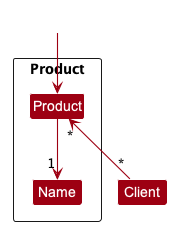
3.5 Storage component
API : Storage.java

The Storage component,
- can save both MyInsuRec data and user preference data in json format, and read them back into corresponding objects.
- inherits from both
MyInsuRecStorageandUserPrefStorage, which means it can be treated as either one (if only the functionality of only one is needed). - depends on some classes in the
Modelcomponent (because theStoragecomponent’s job is to save/retrieve objects that belong to theModel)
3.6 Common classes
Classes used by multiple components are in the seedu.address.commons package.
4. Implementation
This section describes some noteworthy details on how certain features are implemented.
4.1 Client-related features
4.1.1 Add client with product
Syntax: addClient n/NAME p/PHONE_NUMBER [a/ADDRESS] [e/EMAIL] [b/BIRTHDAY] [pd/PRODUCT]...
Purpose: Adds a client with the given information to the internal model and storage
Here, we are interested in the use of adding a client and associating it with a product.
Implementation
Below is an activity diagram that illustrates how a user might use the addClient feature and associate the added client with a product.
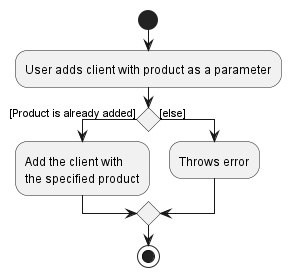
Design Considerations
We decided to only allow adding of a client with its product only after the product is already added using addProduct.
This is to try and maintain the overall cleanliness and housekeeping of MyInsuRec. Suppose we allow the user to add the client with any product name without it already existing in the product list. This might be organized and clean for the first few contacts added, but over time, the product name can get distorted. Shorthand forms may be used in place of the product name, case sensitivity and whitespaces are ignored. With MyInsuRec also placing a focus on allowing users to get an idea of the popularity of each of the products they are selling, it is paramount that the product name stay the same, so as to enable the feature to work. Furthermore, one of the problems we are attempting to solve is the messiness of using traditional Excel spreadsheets. Having this validation check helps to preserve the data added, and thus the user can use the app for a longer time without feeling cluttered.
4.1.2 Birthday constraints
Below is the activity diagram that illustrates the process of validating birthday when birthday of a client is added.
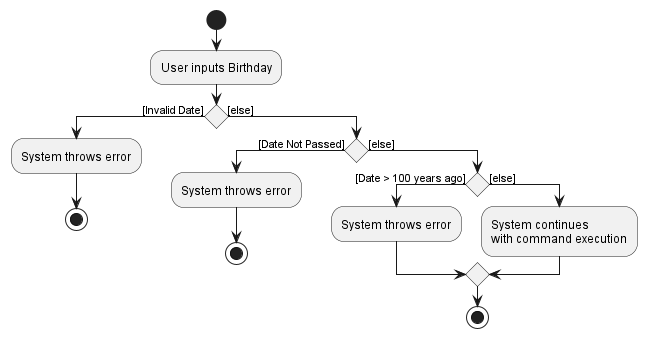
We decided to set these 2 constraints on birthday:
1) Birthday should not be in the future.
2) Birthday should not be more than 100 years ago as we feel that client would not be able to buy product due to age limit.
4.1.3 View client
Syntax: viewClient i/INDEX, where INDEX is an index shown in the client list.
Purpose: View details associated to the client, such as the client’s birthday and address, as well as the meeting details with the client.
Implementation
Usage Scenario of viewClient:
1) User inputs viewClient i/1 to view the first client in the Model.
INDEX is larger than the current client list’s size or INDEX is negative, then it will not show any client details. It will return an error to the user.
Below is a sequence diagram that illustrates the execution of viewClient command and the interaction with Model.
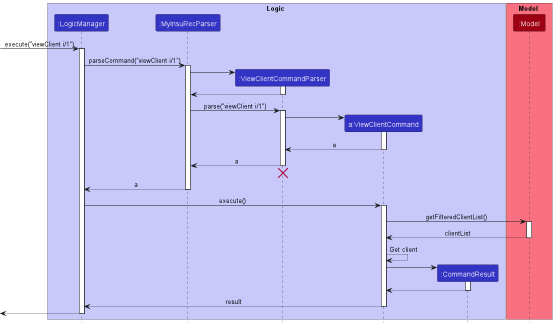
Below is an activity diagram that summarises the execution of viewClient.
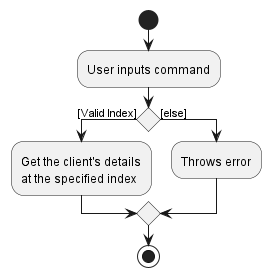
4.1.4 Delete Client
Syntax: delClient i/INDEX, where INDEX is an index shown in the client list.
Purpose: Delete client from model and storage.
Implementation
Usage Scenario of delClient:
1) User inputs listClient to view the current list of clients in Model with their respective indexes.
2) User inputs delClient i/1 to delete the first client in the shown in listClient. This will evoke the Command#execute in LogicManager.
The sequence diagram below illustrates the interactions between the Logic and Model after the execution of delClient i/1.
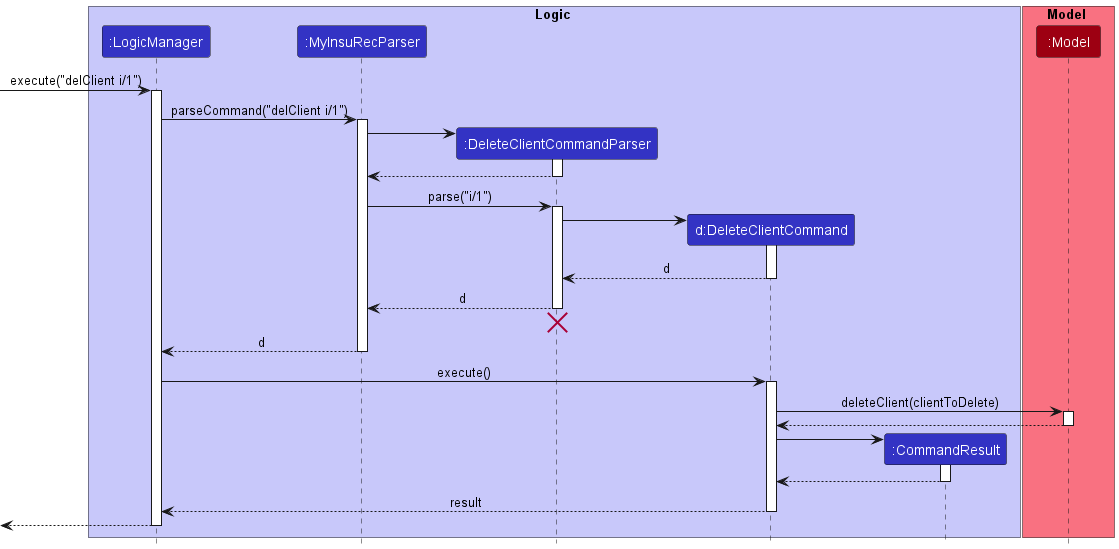
Below is the activity diagram that summarises the execution of delClient.

4.1.5 Edit Client feature
Syntax: editClient i/INDEX [n/NAME] [p/PHONE_NUMBER] [a/ADDRESS] [e/EMAIL] [b/BIRTHDAY] [pd/PRODUCT]
Purpose: Edit a Client from the UniqueClientList in Model.
Implementation
Usage Scenario of editClient:
1) User inputs editClient i/1 a/123 Street to edit the first client in the Model by adding an address.
Below is a sequence diagram that illustrates the execution of editClient i/1 a/123 Street command and the interaction with Model.
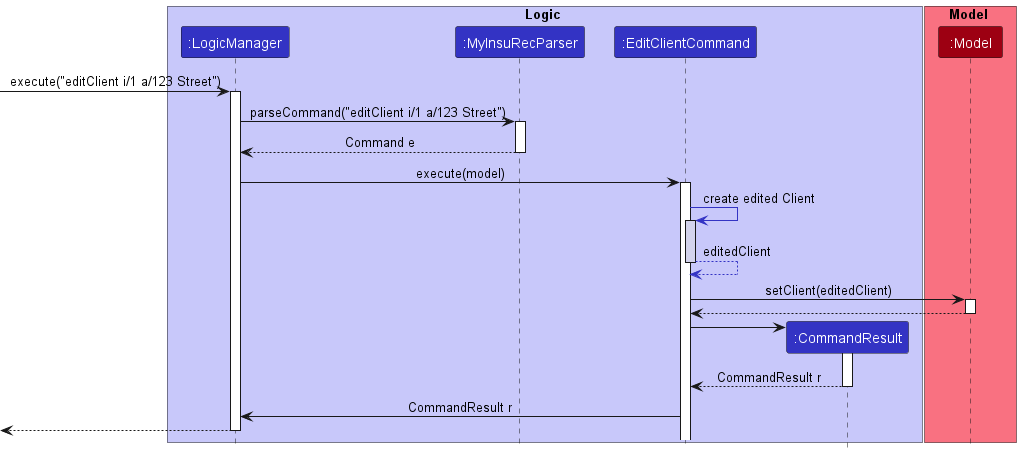
4.2 Meeting-related features
4.2.1 Add meeting
Syntax: addMeeting i/INDEX d/DATE st/START_TIME et/END_TIME dn/DESCRIPTION
Purpose: Adds a meeting with the given information to the internal model and storage
Implementation
In keeping with the command execution structure of the overall program, the command specific classes AddMeetingCommand and AddMeetingCommandParser were added to the commands and parser packages respectively. The main parser MyInsuRecParser was also modified to accept the new command word, addMeeting.
Usage scenario of addMeeting:
1) User inputs addMeeting i/1 st/1000 et/1100 d/12122022 dn/Meeting with Alex to add a meeting with the first client in the list.
Below is a sequence diagram that illustrates the execution of addMeeting i/1 st/1000 et/1100 d/12122022 dn/Meeting with Alex command and the interaction with Model.
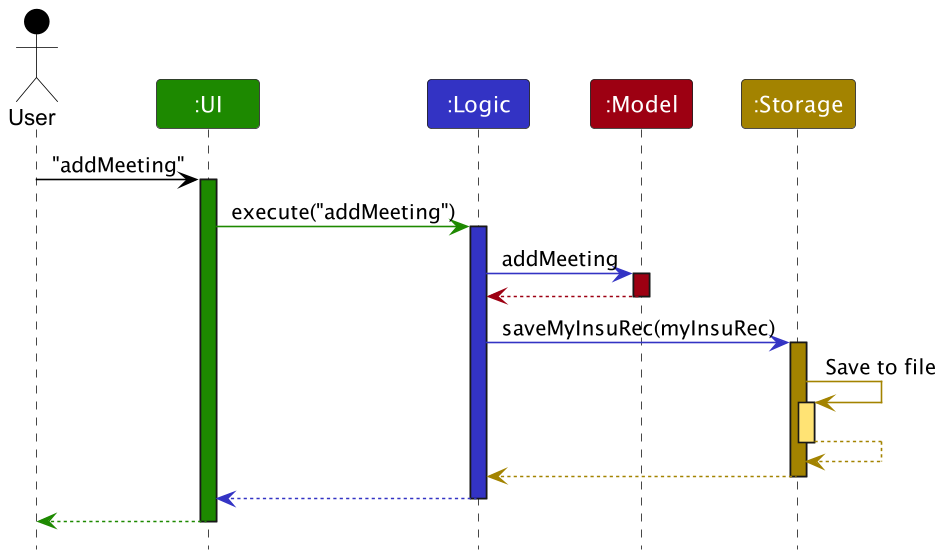
Design Considerations
Aspect: What the addMeeting command accepts as a reference to a client:
-
Alternative 1 (current choice): Accept the client’s list index.
- Pros: Each valid index is guaranteed to refer to a unique client.
- Cons: It is less intuitive for the user compared to typing in a name.
-
Alternative 2: Accept the client’s name.
- Pros: It is intuitive for the user to enter a name.
- Cons: Names have to be spelt exactly as stored, otherwise the name. could be referencing more than one client.
Aspect: The parameters that the AddMeetingCommand constructor should accept:
-
Alternative 1 (current choice): Accept the parsed command arguments separately.
- Pros: The logic and operations on the model that are associated with command execution are inside the AddMeetingCommand.
- Cons: The design of AddMeetingCommand is less intuitive.
-
Alternative 2: Accept a completed Meeting.
- Pros: The design of AddMeetingCommand is simpler.
- Cons: The parser will need to have access to the model in order to obtain the referenced client.
4.2.2 Meeting date constraints
Below is the activity diagram that illustrates the process of validating meeting date.
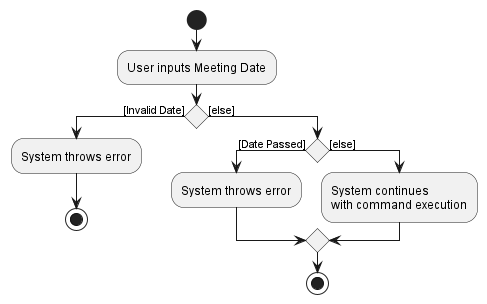
We decided to set this constraint on meeting date:
1) Meeting Date is not in the past.
4.2.3 Delete meeting
Syntax: delMeeting i/INDEX, where INDEX is an index shown in the meeting list.
Purpose: Delete a specified Meeting from the Meeting List in Model
Implementation
Usage Scenario of delMeeting:
1) User inputs listMeeting to view the current meetings in the Model’s Meeting List with their respective indexes.
2) User then inputs delMeeting i/1 to delete the first meeting shown in listMeeting. This will evoke Command#execute in LogicManager.
The sequence diagram and activity diagram of delMeeting is similar to the diagrams shown in delClient feature by replacing all occurrence of client with meeting.
Design Considerations
Aspect: How many meetings to delete in one command
-
Alternative Solution 1 (Current Choice): Allows only one deletion
- Pros: Easy to implement
- Cons: Troublesome in the event where multiple meetings
-
Alternative Solution 2: Allows multiple deletion
- Pros: Convenient to delete multiple meetings when needed.
- Cons: Complex to implement
- Considering that the approach taken to develop MyInsuRec is a breath first approach, where we should only build to the point where every iteration is a working product, Solution 1 is thus chosen as it is easier to implement. However, Solution 2 could be a possible implementation for future iteration.
4.2.4 View meeting
Syntax: viewMeeting i/INDEX, where INDEX is an index shown in the meeting list.
Purpose: View details associated with a meeting, such as meeting’s date and time.
Implementation
Usage Scenario of viewMeeting:
1) User inputs viewMeeting i/1 to view the first meeting in the Model.
INDEX is larger than the current meeting list’s size or INDEX is negative, then it will not show any meeting details. It will return an error to the user.
The sequence diagram and activity diagram of viewMeeting is similar to the diagrams shown in viewClient feature by replacing all occurrence of client with meeting.
4.2.5 List meeting
Syntax: listMeeting [d/PERIOD]
Purpose: View all Meeting from the Meeting List in Model, optionally using d/PERIOD to filter out Meeting from a specific time period.
Implementation
Usage Scenario of listMeeting:
1) User inputs listMeeting d/tomorrow to view the meetings for tomorrow in the Model.
Below is a sequence diagram that illustrates the execution of listMeeting d/tomorrow command and the interaction with Model.

Design Considerations
Aspect: What the listMeeting command accepts for the PERIOD prefix:
-
Alternative 1 (current choice): Use the same prefix as
DATE(that is,d/)- Pros: Users will have to remember lesser prefixes for specifying inputs for a similar domain of dates.
- Cons: It might be slightly confusing what values can be used for a specific prefix.
-
Alternative 2: Use another prefix e.g.,
prd/- Pros: It might be more intuitive for a new user.
- Cons: There is limited number of short, representative prefixes that can be used and we feel that we are using quite a number of prefixes already. For example, we want to use
pd/as a shorthand forPERIOD, but that is taken up byPRODUCTalready. We want to usep/, but that is also taken up byPHONE. So we feel that it is best to use a keyword in a similar domain.
4.2.6 Edit Meeting feature
Syntax: editMeeting i/INDEX [d/DATE] [st/START TIME] [et/END TIME] [dn/DESCRIPTION]
Purpose: Edit a Meeting from the NoConflictMeetingList in Model
Implementation
Usage Scenario of editMeeting:
1) User inputs editMeeting i/1 d/09112023 to edit the first meeting in the Model by changing its date.
Every Meeting is uniquely identified by a UUID in storage, so essentially all fields in a Meeting can be edited without loss of its uniqueness.
Below is an activity diagram that summarizes how the updates are reflected in MyInsuRec.
EditMeetingCommand#execute caused the model to be updated first and then the storage.

Below is a sequence diagram that illustrates the execution of editMeeting i/1 d/09112023 command and the interaction with Model.
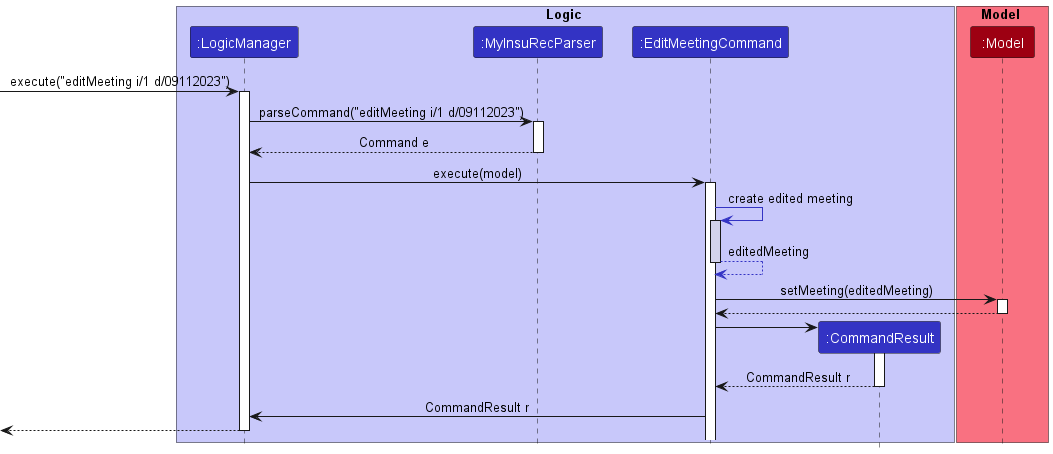
Design Considerations
Aspect: Class that triggers Model and Storage update
-
Alternative Solution 1 (current choice):
LogicManager#executecauses both updates- Pros: Any error in updating storage or model can be identified within
execute(). - Cons: Execute command performs two functions, update model and update storage, which is not ideal for separating responsibilities.
- Pros: Any error in updating storage or model can be identified within
-
Alternative Solution 2:
LogicManagercausesModelupdate which internally triggersStorageupdate- Pros: Removes one instance of cohesion between
LogicandStorage(Logiccan accessStorageviaModelonly). - Cons:
Modelis a single point of failure in this scheme.
- Pros: Removes one instance of cohesion between
-
LogicManageris responsible for coordinating bothModelandStorageupdates becauseModelandStorageshould be kept as separate entities according to the architecture. Solution 1 is thus chosen as it maintains the design pattern chosen in the architecture.

4.3 Product-related features
4.3.1 Add product
Syntax: addProduct pd/PRODUCT_NAME
Purpose: Add a self-defined product with a name PRODUCT_NAME into the product list to keep track of the products that the financial advisor sells.
Implementation
Usage Scenario of addProduct:
1) User inputs addProduct pd/PrudenSure to add PrudenSure in the product list.
Below is a sequence diagram that illustrates the execution of addProduct command.
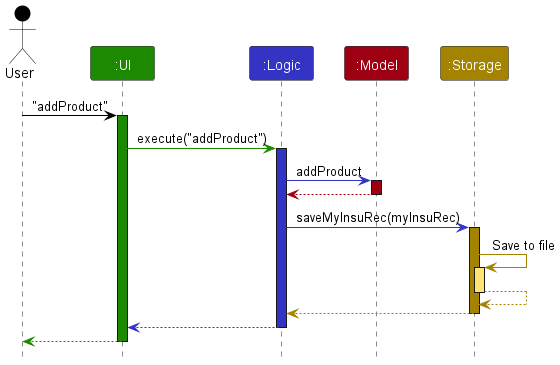
Below is an activity diagram that summarises the execution of addProduct.
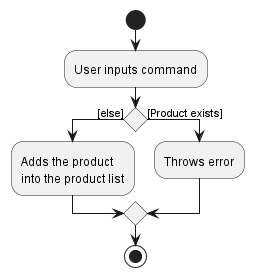
4.4 UI
4.4.1 Different view panels
View panels are one of the main component of the UI and the main component where a user sees the results of their commands. Examples of view panel include MeetingListPanel, ClientDetailedViewPanel and more.
The GUI changes view panels depending on the last executed command. For example, a listMeeting will cause the meeting list view panel to be displayed, while viewClient i/1 will cause a detailed client view panel to be displayed.
Implementation
Below is a sequence diagram that illustrates the execution of listMeeting command and the interaction with Model, which demonstrates how a view panel changes to MeetingListPanel.
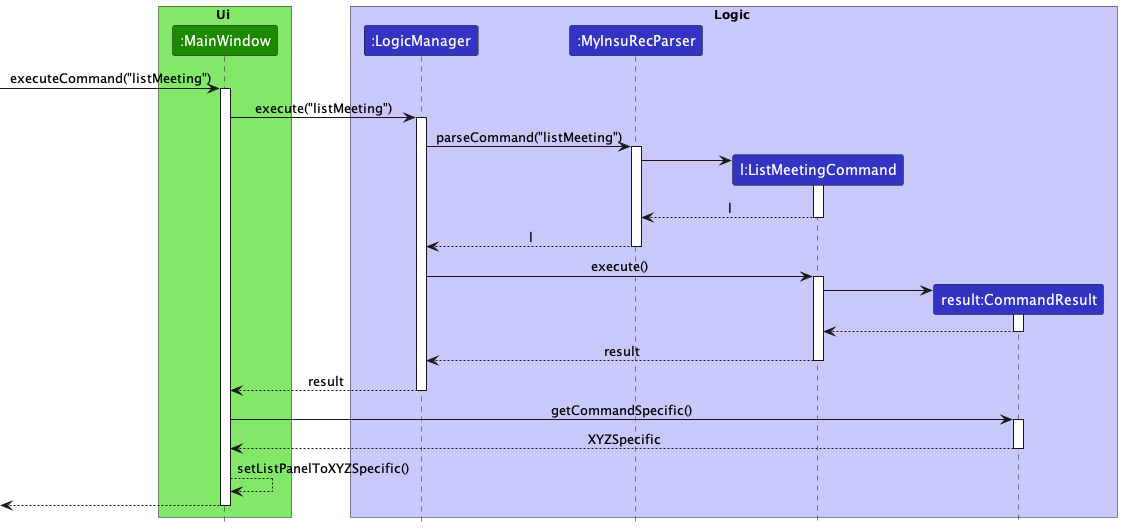
Rationale
We chose to implement the changing of view panels through CommandResult due to its simplicity and the intended effects are clear. Furthermore, this is in line with how HelpCommand and ExitCommand is implemented.
Design Considerations
Aspect: The method used to change view panels
-
Alternative 1 (current choice): Pass the specific view through
CommandResultusing enumCommandSpecific.- Pros: Simple and clear. It is also in line with how some other commands are implemented, and is the most natural manner to communicate with the UI from the Logic.
- Cons: If we have too many views, we will need a lot of different
CommandSpecific. Furthermore, our switch statements may get bloated.
-
Alternative 2: Use listeners on the model. For example, we can have listeners on
filteredClientsto change views when changes happen onfilteredClients.- Pros: Cleaner design. We will not need a separate enum.
- Cons: Harder to implement. Increases coupling as well, as
Modelskips communications throughLogicto getUIto change views directly, which is not in line with the architecture diagram.
- Ultimately, we believe that we will not have too many views (likely a maximum of 6 as we only have to consider
Client,Meeting,Productand their detailed variant). As such, we felt that passing theCommandSpecificis a cheaper (in terms of effort and programming hours and research) and better solution for now.
Aspect: Different view panels do not inherit from a single abstract panel class
- View panels include not only
ListPanel, but alsoDetailedViewPanel. - Within in view panel class, there are similar structures (FXML file name attribute, Logger, ListView, constructor, overwriting ListCell etc.), but that is where the similarities end. We feel that having the panels inherit from a single panel does not necessarily add any value, as they do not share any attribute or methods. We find that the use of polymorphism here to make all the different view panels inherit from a single parent class is an example of over engineering and adds no value to justify the effort of doing so.
- Only within the three
ListPanel, there is a single common methodnumRecordsString, which checks for plurality of the word ‘record’. As such, a small bit of polymorphism in an abstract classListPanelis incorporated in an attempt to reduce repetition.
4.5 Proposed Features
4.5.1 Multiple possible prefixes per command
Purpose: With this proposed feature, users can have multiple possible prefixes for defining fields in a command.
For example, currently in MyInsuRec we can define a client’s birthday using the b/ prefix only.
However, since a birthday is essentially a date, a user may prefer to reuse the d/ prefix instead for defining a client’s birthday(see addMeeting command).
Proposed Implementation
Currently, in MyInsuRec, AddClientCommandParser depends on multiple Prefix objects such as PREFIX_BIRTHDAY, and PREFIX_DATE to identify each field in an AddClientCommand.
Also, the Prefix class stores the required prefix word as a String.
In this proposed implementation, we instead change the prefix word stored in Prefix class to a Pattern which can be matched against using Matcher class.
Then, for all prefixes we are looking for, we first get the matching pattern using getPrefix().
Later, findPrefixPosition() validates the presence of a field and also obtains the index of its first occurrence.
From then on, the AddClientCommand can be built as expected.
 g
g
Design Considerations for Proposed Feature
Aspect: How prefixes are stored:
-
Alternative Solution 1 (preferred choice for proposed feature):
Prefix::getPrefixreturns aPatternthatfindPrefixPosition()can match against usingMatcherclass (see diagram below). - Pros:
Matcherhas several useful methods for validating a match. - Case-insensitive matches can be made easily by setting a flag in the
Pattern. - Cons: Regex string used to define a pattern may be difficult to read.
- e.g.
String regexForBirthday = "[b|d|birthday|birthdate][\\\\]"is not as clear as Alternative 2
- e.g.
-
Alternative Solution 2: Store each possible prefix as a
Stringin aListmaintained byPrefix. - Pros:
Stringmatches are easier to understand than regexes.- e.g.
String[] patternsForBirthday = {"b", "d", "birthday", "birthdate"}are all possible prefixes and can be used to check for finding matches.
- e.g.
- Cons:
ListofStringreturned is cumbersome for pattern matching, i.e. Iterate through everyStringinpatternsForBirthdayto look for a match. -
Solution 1 is the preferred proposed feature because:
- A single
Patternfor eachPrefixis more succinct that aList. - No need to iterate through a list of
Stringsto find a match. - Matches can be made using pre-existing methods in
Matcherclass (no need to rely onStringmethods)
- A single
5. Documentation, logging, testing, configuration, dev-ops
6. Appendix: Requirements
6.1 Product scope
Target user profile:
- insurance agent
- has a need to manage a significant number of client contacts
- has a need to look up client’s information
- has a need to track a significant amount of meetings
- requires reminders regarding meeting schedules.
- prefer desktop apps over other types
- can type fast
- prefers typing to mouse interactions
- is reasonably comfortable using CLI apps
Value proposition:
- manage clients’ information faster than a typical mouse/GUI driven app
- view scheduled meetings with client’s details in one glance
- less effort to recall client’s information, more effort to satisfy client’s needs
6.2 User stories
Priorities: High (must have) - * * *, Medium (nice to have) - * *
| Priority | As an … | I want to … | So that I can… | Conditions |
|---|---|---|---|---|
* * * |
insurance agent | add client details | keep track of my client’s details | |
* * * |
insurance agent | view all my clients | see who I am providing services to | |
* * * |
insurance agent | delete clients’ details | remove clients whom I am no longer serving | |
* * * |
insurance agent | update my clients details | have the latest contact details to keep in touch with my clients. | All fields that uniquely identify a client should be uneditable |
* * * |
insurance agent | add client meetings | keep track of when to meet clients | Meetings with timing conflict are not allowed |
* * * |
insurance agent | view all client meetings | see when I have meetings | |
* * * |
insurance agent | see an overview of today’s client meetings | know what my schedule looks like for the day | |
* * * |
insurance agent | delete client meetings | remove meetings that are canceled | |
* * |
insurance agent | see an overview of future client meetings | know what my schedule looks like for at least the coming month | |
* * |
insurance agent | add and edit a list of the products a client bought | better track which products might interest them | Product are created by the agent before being associated with a client |
* * |
insurance agent | know which products my clients have bought | gauge the popularity of each product | Clients can be filtered according to the product they bought |
* * |
insurance agent | see the birthdays of my clients for the upcoming week/month | send my clients a thank you/birthday gift and maintain a close relationship | |
* * |
insurance agent | set the default views in my app to light mode and dark mode |
6.3 Use cases
(For all use cases below, the System is the MyInsuRec and the Actor is the insurance agent, unless specified otherwise)
6.3.1 Use case: UC1 - Add a client
MSS
- User requests to add a client.
- System adds the client.
-
System informs user that client has been added.
Use case ends.
Extensions
- 1a. User inputs incomplete or invalid data.
-
1a1. System shows an error message.
Use case ends.
-
6.3.2 Use case: UC2 - List all clients
MSS
- User requests for a list of all clients.
-
System shows a list of all clients.
Use case ends.
Extensions
- 1a. User requests for a list of all clients whose birthday falls within a given period.
-
1a1. System shows a list of all clients whose birthday falls within the period.
Use case ends.
-
- 1b. User requests for a list of all clients who has purchased a given product.
-
1b1. System shows a list of all clients who has purchased the product.
Use case ends.
-
6.3.3 Use case: UC3 - View a client
MSS
- User requests for a list of all clients (UC2).
- System shows a list of clients.
- User selects client to view.
-
System displays the client information.
Use case ends.
Extensions
- 1a. User selects a non-existent client.
-
1a1. System shows an error message.
Use case ends.
-
6.3.4 Use case: UC4 - Delete a client
MSS
- User requests for a list of all clients (UC2).
- System shows a list of clients.
- User requests to delete a client by specifying the index of the client.
- System removes the client.
-
System informs user that the specified client has been removed.
Use case ends.
Extensions
- 1a. User attempts to delete a non-existent client.
-
1a1. System shows an error message.
Use case ends.
6.3.5 Use case: UC5 - Edit a client
-
MSS
- User requests for a list of all clients (UC2).
- System shows a list of clients.
- User requests to edit a client by specifying the index of the client.
- System replaces current client information with the new information.
-
System informs user that the specified client has been updated.
Use case ends.
Extensions
- 1a. User attempts to edit a non-existent client or inputs invalid data.
-
1a1. System shows an error message.
Use case ends.
-
6.3.6 Use case: UC6 - Add a meeting
MSS
- User requests for a list of all clients (UC2).
- System shows a list of clients.
- User requests to add a meeting to a specific client by specifying the index of the client.
- System adds the meeting.
-
System informs user that meeting has been added.
Use case ends.
Extensions
- 1a. User inputs incomplete or invalid meeting data.
-
1a1. System shows an error message.
Use case ends.
-
6.3.7 Use case: UC7 - List all meetings
MSS
- User requests for a list of all meetings.
-
System shows a list of all meetings.
Use case ends.
Extensions
- 1a. User requests for a list of all meetings in a given period.
-
1a1. System shows the list of all meetings in the period.
Use case ends.
-
6.3.8 Use case: UC8 - View a meeting
MSS
- User requests for a list of all meetings (UC7).
- System shows a list of all meetings.
- User requests to view a meeting in detail by specifying the index of the meeting.
-
System shows the meeting details.
Use case ends.
Extensions
- 1a. User selects a non-existent meeting or inputs an invalid index.
-
1a1. System shows an error message.
Use case ends.
-
6.3.9 Use case: UC9 - Delete a meeting
MSS
- User requests for a list of all meetings (UC7).
- System shows a list of all meetings.
- User requests to delete one meeting from the list.
- System deletes the meeting specified by the user.
-
System informs user that the specified meeting is deleted.
Use case ends.
Extensions
- 3a. User deletes a non-existent meeting.
-
3a1. System shows an error message.
Use case ends.
6.3.10 Use case: UC10 - Edit a meeting
-
MSS
- User requests for a list of all meetings (UC7).
- System shows a list of all meetings.
- User requests to edit a meeting by specifying the index of the meeting.
- System replaces current meeting information with the new information.
-
System informs user that the specific meeting has been updated.
Use case ends.
Extensions
- 1a. User attempts to edit a non-existent meeting or inputs invalid data.
-
1a1. System shows an error message.
Use case ends.
-
6.3.11 Use case: UC11 - Add a product
MSS
- User requests to add a product.
- System adds the product.
-
System informs user that the product has been added.
Use case ends.
Extensions
- 1a. User inputs incomplete product data.
-
1a1. System shows an error message.
Use case ends.
-
6.3.12 Use case: UC12 - List all products
MSS
- User requests for a list of all products.
-
System shows a list of all products.
Use case ends.
6.3.13 Use case: UC13 - Delete a product
MSS
- User requests for a list of all products (UC12).
- System shows a list of all products.
- User requests to delete one product from the list.
- System deletes the product specified by the user.
-
System informs user that the specified product is deleted.
Use case ends.
Extensions
- 1a. User tries to delete a product that was not shown in the list.
-
1a1. System shows an error message.
Use case ends.
-
6.4 Non-Functional Requirements
- Should work on any mainstream OS as long as it has Java
11or above installed. (Technical requirement) - Should be able to hold up to 1000 clients without a noticeable sluggishness in performance for typical usage. (Performance requirements)
- A user with above average typing speed for regular English text (i.e. not code, not system admin commands) should be able to accomplish most of the tasks faster using commands than using the mouse. (Constraints)
- Should be usable by a novice who has never used a command line interface. (Accessibility requirements)
- Common actions should require 5 or less input phrases to accomplish. (Quality requirements)
- Should be able to work without an internet connection. (Constraints)
- Should not take more than 10 seconds to execute any commands. (Performance requirements)
6.5 Glossary
Quick Reference
C
Command Line Interface
A text-based user interface that allows users to interact with a system.
M
Mainstream OS
Windows, MacOS, Unix.
Meeting
An event scheduled between the user and a client at a specific date and time.
P
Product
A financial product such as life insurance that a financial advisor is selling.
T
Timing Conflict
Time periods that overlap. e.g., a time period spanning from 1400 to 1500 and another time period spanning from 1430 to 1500 are considered to overlap. Time period that start and end at the same time however are considered to not overlap, e.g., a time period spanning from 0900 to 0900 and another time period spanning from 0900 to 0900 are considered to not overlap.
V
View Panel
The main and largest component of the user interface the user will be interacting with. e.g., the view panel is the component that is used to display the list of clients, show detailed information about a meeting, etc.
7. Appendix: Instructions for manual testing
Given below are instructions to test the app manually.
7.1 Launch and shutdown
- Initial launch
- Download the jar file and copy into an empty folder.
- Run the jar file via
java -jar MyInsuRec.jar- Expected: Shows the GUI with a set of sample clients and products. The window size may not be optimum.
- Saving window preferences
- Resize the window to an optimum size. Move the window to a different location. Close the window.
- Re-launch the app by double-clicking the jar file.
- Expected: The most recent window size and location is retained.
- Subsequent launches, with data edited
- Run the jar file via
java -jar MyInsuRec.jar- Expected: Shows the GUI with the correct edited data.
- Run the jar file via
7.2 Adding a client
-
Prerequisites: No other client have the exact same name.
- Add client with only essential information
- Test case:
addClient n/John Tan p/89134083- Expected: A client named John Tan and phone number 89134083 is added and the view switches back to the list of client, where the list is updated with John Tan’s newly added record.
- Test case:
- Add client with same phone number as another client
- Test case:
addClient n/Trevor Tan p/89134083- Expected: A client named Trevor Tan and phone number 89134083 is added and the view switches back to the list of client, where the list is updated with Trevor Tan’s newly added record. This test case focuses on the fact that the phone numbers are identical, which happens when parents buy policies for their child who does not have a cellular plan.
- Test case:
- Add duplicate client of the same name
- Test case:
addClient n/Trevor Tan p/89134083- Expected: No client is added and an error message is shown. This tests whether if the app allows clients of the same name, which is not allowed by design.
- Test case:
- Add client with an optional field
- Test case:
addClient n/Justin Lim p/98120931 e/justinlim@gmail.com- Expected: A client named Justin Lim and phone number 98120931 is added and the view switches back to the list of client, where the list is updated with Justin Lim’s newly added record. This test case focuses on the fact that an optional field is used.
- Test case:
- Add client with a non-existent product
- Test case:
addClient n/Tom p/90231494 pd/ProductTest- Expected: No client is added as the product
ProductTestis not added beforehand.
- Expected: No client is added as the product
- Test case:
- Add client with an existing product
- Continuation:
addProduct pd/ProductTest, thenaddClient n/Tom p/90231494 pd/ProductTestagain.- Expected: The client should now be added with the product as the product is added with the
addProductcommand.
- Expected: The client should now be added with the product as the product is added with the
- Continuation:
- Add client with no name prefix,
/n- Test case:
addClient Tom p/12345678- Expected: No client will be added. Error regarding the command format will be shown.
- Test case:
- Add client with special character in name
- Test case:
addClient n/O'neal p/12345678- Expected: No client will be added. Error regarding the wrong name input will be shown.
- Test case:
- Add client with invalid phone number
- Test case:
addClient n/Tom p/12345- Expected: No client will be added. Error regarding the wrong phone input will be shown.
7.3 Viewing a client
- Expected: No client will be added. Error regarding the wrong phone input will be shown.
- Test case:
listClient where the index number of the client can be found.
-
Prerequisites: View a specific client’s details using the
viewClientcommand. There is exactly one client in the list. - View client at index 1
- Test case:
viewClient i/1- Expected: The details of the client who is at the first index is shown.
- Test case:
- View client using non-numeric index
- Test case:
viewClient i/a- Expected: The index is not numeric, so there will be an error.
- Test case:
- View client using an index out of range
- Test case:
viewClient i/2- Expected: Index is larger than the size of client list, so there will be an error.
- Test case:
- View client using index 0
- Test case:
viewClient i/0- Expected: Index less than 1 is not allowed, therefore there will be an index error.
- Test case:
- View client without providing index
- Test case:
viewClient i/- Expected: Index is not provided, so there will be an error.
- Test case:
- View client without using prefix
- Test case:
viewClient 1- Expected: Prefix for index is not provided, so there will be an invalid command format error.
- Test case:
7.4 Deleting a client
listClient where the index number of the client can be found.-
Prerequisites: Requires multiple clients in the list (more than 1, recommended to have 3).
- Delete client at index 1
- Test case:
delClient i/1- Expected: First client is deleted from the list. Details of the deleted client shown in the status message. Timestamp in the status bar is updated.
- Test case:
- Delete client using index 0
- Test case:
delClient i/0- Expected: No client is deleted. Error regarding invalid index input will be shown.
- Test case:
- Delete client without parameters
- Test case:
delClient- Expected: No client is deleted. Error regarding invalid command format will be shown.
7.5 Listing meetings
- Expected: No client is deleted. Error regarding invalid command format will be shown.
- Test case:
- Prerequisites: One existing client, one meeting with date set to tomorrow (of system date), another set to within one week (but not tomorrow), another set to within one month (but not the next week).
- To add the meetings, you can use the commands below (replace the dates with appropriate dates)
addMeeting i/1 dn/Test st/1200 et/1300 d/<date tomorrow>addMeeting i/1 dn/Test st/1200 et/1300 d/<date in the current week (but not tomorrow)>addMeeting i/1 dn/Test st/1200 et/1300 d/<date in the current month (but not tomorrow or the current week)>
- To add the meetings, you can use the commands below (replace the dates with appropriate dates)
- List all meetings
- Test case:
listMeeting- Expected: The view switches back to the list of meetings, and all three meetings are displayed.
- Test case:
- List meetings happening tomorrow
- Test case:
listMeeting d/tomorrow- Expected: The view switches back to the list of meetings, and only the meeting tomorrow is displayed.
- Test case:
- List meetings happening in the week
- Test case:
listMeeting d/week- Expected: The view switches back to the list of meetings, and the meetings tomorrow and in the next week are displayed.
- Test case:
- List meetings happening in the month
- Test case:
listMeeting d/month- Expected: The view switches back to the list of meetings, and all three meetings are displayed.
- Test case:
- List all meetings, with extra nonsensical parameters
- Test case:
listMeeting adsfadsf- Expected: The view switches back to the list of meetings, and all three meetings are displayed. Extra parameters are ignored.
- Test case:
7.6 Deleting a Meeting
Deleting a meeting while all meetings are being shown
-
Prerequisites: List all meetings using the
listMeetingcommand. At least one meeting in the list. - Delete meeting at index 1
- Test case:
delMeeting i/1- Expected: First meeting is deleted from the list. Details of the deleted meeting shown in the status message. Timestamp in the status bar is updated.
- Test case:
- Delete meeting using index 0
- Test case:
delMeeting i/0- Expected: No meeting is deleted. Error regarding invalid index input will be shown.
- Test case:
- Delete meeting without parameters
- Test case:
delMeeting- Expected: No meeting is deleted. Error regarding invalid command format will be shown.
- Test case:
7.7 Viewing a meeting
listMeeting where the index number of the meeting can be found.-
Prerequisites: View a specific meeting’s details using the
viewMeetingcommand. There is exactly one meeting in the list. - View meeting at index 1
- Test case:
viewMeeting i/1- Expected: The details of the meeting who is at the first index is shown.
- Test case:
- View meeting using non-numeric index
- Test case:
viewMeeting i/a- Expected: The index is not numeric, so there will be an error.
- Test case:
- View meeting using an index out of range
- Test case:
viewMeeting i/2- Expected: Index is larger than the size of meeting list, so there will be an error.
- Test case:
- View meeting using index 0
- Test case:
viewMeeting i/0- Expected: Index less than 1 is not allowed, therefore there will be an index error.
- Test case:
- View meeting without providing index
- Test case:
viewMeeting i/- Expected: Index is not provided, so there will be an error.
- Test case:
- View meeting without using prefix
- Test case:
viewMeeting 1- Expected: Prefix for index is not provided, so there will be an invalid command format error.
7.8 Adding a product
- Expected: Prefix for index is not provided, so there will be an invalid command format error.
- Test case:
-
Prerequisites: No other product have the exact same name.
- Add product with valid name
- Test case:
addProduct pd/MyInsureCare- Expected: A product named MyInsureCare is added and the view switches back to the list of product, where the list is updated with the newly added product.
- Test case:
- Add product with empty field
- Test case:
addProduct pd/- Expected: Empty fields are not allowed, so no product is added.
- Test case:
7.9 Listing products
- List all meetings
- Test case:
listProduct- Expected: The list of product view shows up.
- Test case:
- List all meetings, with extra nonsensical parameters
- Test case:
listProduct adfafio3- Expected: The list of product view shows up. Any other parameter or input added after the command is ignored.
- Test case:
7.10 Delete product
listProduct where the index number of the product can be found.-
Prerequisites: There is at least one product already added.
- Delete product at index 1
- Test case:
delProduct i/1- Expected: The list of product view shows up (if not already in it), and the first product is deleted.
- Test case:
- View product with non-positive index
- Test case:
delProduct i/-1- Expected: No product is deleted and an error message shows up as the index is invalid.
- Test case:
8. Appendix: Effort
MyInsuRec is a brown-field project that extends from AB3. It is developed to become a financial advisor’s everyday companion app, used for its client contacts tracking, meetings scheduling and products management ability.
Our team has put in a substantial effort in developing this product. To date, we have over 12,000 lines of code. Over 380 automated tests were written, and many hours of writing code and testing them was spent on this.
We have listed our project challenges below in an attempt to bring you closer to the behind-the-scenes of the product development, and help you understand the countless hours and the thoughts put into designing and creating the product.
8.1 Product challenges
Some design considerations and effort is listed below:
-
Careful deliberation on how we can maintain the immutability of all three entity types to match the design of AB3. This was especially challenging as we planned for
ClientandMeetingto have a bidirectional navigability so that we can freely access both object’s information, but this is impossible (literally) as there are no order of creation such that both objects can be immutable. We ultimately settled on a immutable definition that is less strict, and allowsClientto have an immutable attribute of a list of meetings, but strictly control the ways that the list can be changed. -
Integrating the 3 entity types is also challenging as the initial code base is written purely for a single entity. We had to spend hours researching on the use of Jackson to better understand how we can incorporate navigability e.g., having
Clienthave a reference toMeetingand kept inside to-and-fro storage. We ultimately decided on using an ID generator in order to reference fromClientto itsMeeting. -
Having 3 entity type also meant that all 3 view panels in the UI needed to be constantly synchronized with one another. This was more complex than we imagined, as the code base only has event listeners on the
ObservableListwhich is created as a separate copy from theFilteredList. This meant that any mutations to the object will not trigger an update to the UI. That observation alone took us hours googling and reading JavaFx documentations and fiddling through the AB3 code base to figure out why mutations does not cause UI changes. We had to revert some decisions made earlier and revamp the entire code base to be fully immutable for the UI updates to work as intended -
3 entity types also meant triple the testing required. Not just in automated testing, but also in integration test, where we had to ensure that all 3 entities can work together and stay synchronized. For example, ensuring that deletion of 1 entity meant the proper deletion of all the other associated entities.
-
Having 3 entity types also mean that our GUI needed to switch between multiple panels. We had to implement all the different types of possible panels for the 3 entity, plus even more panels due to further variants of the list panel (e.g., detailed view panel). This poised some challenge for our team as we had to take the time to learn JavaFx, which was a library we were initially not adept at using.
-
We implemented meetings with start and end time. Without the availability of interval trees in Java, it was more difficult than expected to ensure that meetings do not have any timing conflicts. We faced a lot of bugs in between trying to get the start and end time duration feature to work, facing regressions after fixing a bug. We eventually managed to produce a version that is relatively bug-free after many iterations spent.
-
We have some attributes for clients optional, which is unlike AB3 where only
Tagis optional. For AB3, the optionalTagis easily implemented as it is implemented as a Set which can simply be empty. For our attributes which are not in a form of data structure, we had to deliberate over how it should be implemented. For example, should it just be a barebones, empty parameter version of the attribute (which was the initial solution used)? How would that affect the software engineering principles that are taught? We eventually settled on the use of Java’ Optional which suited our needs better, after facing bugs with using the barebones version of an attribute.